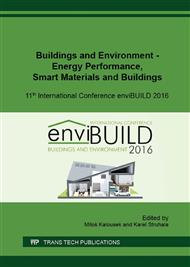[1]
STN 73 0580-1: 1987. Denné osvetlenie budov. Časť 1: Základné požiadavky. (Daylighting in buildings. Part 1: Basic requirements). ÚNM, Praha.
Google Scholar
[2]
ČSN 73 0580 – 1: 2007. Denní osvětlení budov. Část 1: Základní požadavky. (Daylighting in buildings - Part 1: Basic Requirements). ČNI, Praha.
Google Scholar
[3]
DIN 5034-1: 2011. Tageslicht in Innenräumen - Teil 1: Allgemeine Anforderungen (Daylighting in indoors – Part 1 – General requirements).
Google Scholar
[4]
BS8206-2: 2008. Lighting for Buildings - Part 2: Code of practice for daylighting.
Google Scholar
[5]
Information on http: /idmp. entpe. fr.
Google Scholar
[6]
D. Dumortier, M. Fontoynont and P. Avouac-Bastie, Daylight availability in Lyon. Proc. of the European Conf. on Energy Performance and Indoor Climate in Buildings, Lyon, 1994, pp.1315-1320.
Google Scholar
[7]
H.D. Kambezidis, Th. Oikonomou and D. Zevgolis, Daylight climatology in the Athens urban environment: guidance for building designers, Lighting Res. Technol. 34 4 (2002) 297.
DOI: 10.1191/1365782802li037oa
Google Scholar
[8]
A. Bartzokas, S. Darula, H. Kambezidis and R. Kittler, Sky luminance distribution in Central Europe and the Mediterranean during winter period, J. of Atmospheric and Solar-Terrestrial Physics. 65 1 (2003) 113-119.
DOI: 10.1016/s1364-6826(02)00283-3
Google Scholar
[9]
S. Darula, R. Kittler, Occurrence of standard skies during typical half-days, Renew Energy. 33 (2008) 491-500.
DOI: 10.1016/j.renene.2007.03.029
Google Scholar
[10]
P. Tregenza, Standard skies for maritime climates, Lighting Res. Technol. 31 3 (1999) 97-106.
DOI: 10.1177/096032719903100304
Google Scholar
[11]
D.H.W. Li, C.C.S. Lau and J.C. Lam, Standard skies classification using common climatic parameters, J. of Solar Energy Eng. Trans. of the ASME. 126 3 (2004) 957-964.
DOI: 10.1115/1.1740776
Google Scholar
[12]
M.B. Kobav, G. Bizjak, Development of a substitutive light source for indoor daylight calculations, Build Environ. 40 12 (2005) 1611-1618.
DOI: 10.1016/j.buildenv.2004.12.013
Google Scholar
[13]
R. Kittler, R. Perez and S. Darula, Sky classification respecting energy - efficient lighting, glare and control needs. Proc. IESNA Annual Conf. Cleveland. IESNA, New York, 1996, pp.71-84.
DOI: 10.1080/00994480.1997.10748167
Google Scholar
[14]
M. Perradeau, Climat lumineux à Nantes. Analyse des mesures effectuées en 1991-1994. EN-ECL 94-14L Report. Nantes: CSTB, Décembre, (1994).
Google Scholar
[15]
N. Igawa, H. Nakamura and Y. Koga, Classification method of measured sky luminance distribution data. Proc 23 Session CIE, 1995, pp.230-231.
Google Scholar
[16]
ISO 15469: 2004(E)/CIE S 011/E: 2003. Spatial Distribution of Daylight - CIE Standard General Sky. ISO, Geneva, CIE, Vienna, (2004).
DOI: 10.25039/ds011.2003
Google Scholar
[17]
R. Kittler, S. Darula and R. Perez, A set of standard skies, Polygrafia Publ., Bratislava, (1998).
Google Scholar
[18]
S. K. Wittkopf, A method to construct Virtual Sky Domes for the use in standard CAD-based light simulation software, Architectural Science Review 47 (2004) pp.275-286.
DOI: 10.1080/00038628.2000.9697533
Google Scholar
[19]
J. Mardaljevic, Simulation of annual daylight profiles for internal illuminance, Lighting Res. Technol. 32 (2000) pp.111-118.
DOI: 10.1177/096032710003200302
Google Scholar
[20]
D. Croghan, Transilluminated domical artificial sky, Light and Lighting 57 (1964) pp.290-293.
Google Scholar
[21]
C. Aghemo, A. Pellegrinoand and V.R. M, LoVerso, The approach to daylighting by scale models and sun and sky simulators: A case study for different shading systems, Build. Environ. 43 (2008) p.917–927.
DOI: 10.1016/j.buildenv.2007.01.020
Google Scholar
[22]
M. Navaab, Scale model photometry techniques under simulated sky conditions, J. of the IES Summer (1996) p.160-(1972).
Google Scholar
[23]
L. Michel, C. Roecker and JL. Scartezzini, Performance of a new scanning sky simulator, Lighting Res. Technol. 27 (1995) pp.194-207.
DOI: 10.1177/14771535950270040401
Google Scholar
[24]
Information on http: /sites. cardiff. ac. uk/architecture/about-us/facilities/environmental-lab/sky-dome.
Google Scholar
[25]
Bartenbach. Artificial sky. Künstlicher Himmel, Bartenbach, Innsbruck, (2015).
Google Scholar
[26]
Information on http: /www. donau-uni. ac. at/en/department/bauenumwelt/lichtlabor/13096/ index. php.
Google Scholar
[27]
M. Bodart, A. Deneyer and V. Gilbert, Validation of the Belgian single-patch sky and sun simulator. Build. Environ. 43 (2008) p.1892–(1901).
DOI: 10.1016/j.buildenv.2007.11.005
Google Scholar
[28]
R. Kittler, New artificial overcast and clear sky with artificial sun for daylight research, Lighting Res. Technol. 4 (1974) pp.227-229.
DOI: 10.1177/096032717400600407
Google Scholar
[29]
CIE 22: 1973. Standardisation of luminance distribution on clear skies. Technical Report, CIE Central Bureau, Paris, (1973).
DOI: 10.25039/tr.022.1973
Google Scholar
[30]
Information on http: /www. lumidisp. eu.
Google Scholar
[31]
DALI USB Bridge. IlumTech, Dojc, (2016).
Google Scholar
[32]
ASC V2. 1. Artificial Sky Calibration program. (L. Komar, Calibration of the artificial sky using images. Proc Conf. Lumen V4, 2016, in print).
DOI: 10.1109/lumenv.2016.7745554
Google Scholar


